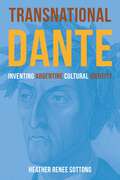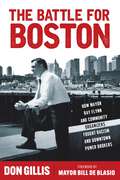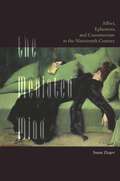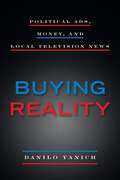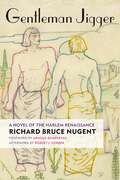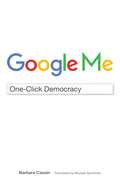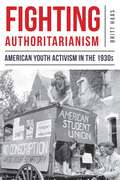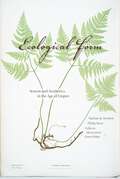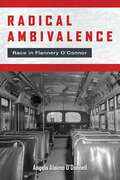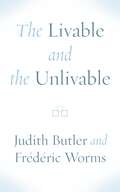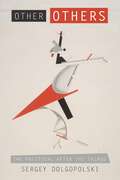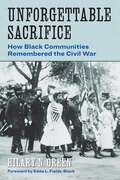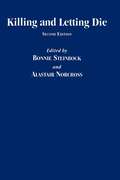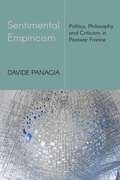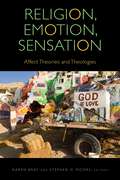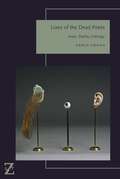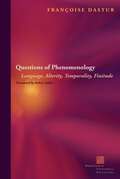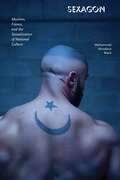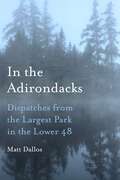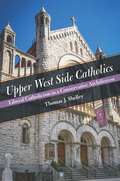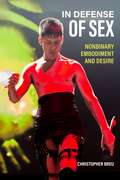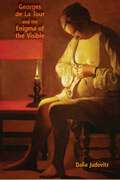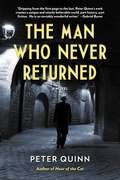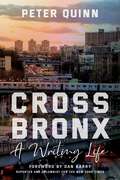- Table View
- List View
Transnational Dante: Inventing Argentine Cultural Identity (Critical Studies in Italian Migrations)
by Heather Renee SottongOpens the field of Dante Studies to further transnational studies of the Divine Comedy’s circulation, translation, and global influenceThis fascinating book examines how Dante was repurposed by Argentine politicians and authors who were concerned with the construction of Argentine national identity in the late nineteenth and early twentieth centuries. Sottong’s work is informed by the theories of Eric Hobsbawm, Benedict Anderson, and Nicolas Shumway, who coined the concepts of “invented traditions,” “imagined communities,” and “guiding fictions,” respectively. Sottong has applied these notions to the case of Argentina, which, after the War of Independence from Spain (1810–1818), had to develop its own national cultural identity.In this volume, she investigates Dante’s transnational influence in Argentina: Why did Argentine authors consistently call upon Dante in their attempts to develop Argentine literature? What are the textual and thematic characteristics of Dante’s Divine Comedy that make it an ideal vehicle for literary appropriation? What are the historical and cultural factors that account for Dante’s enduring popularity in Italy and beyond? How did the strong presence of Italians in Argentina influence cultural production in the developing nation? And how are the re-writings of Dante in the Argentine canon in dialogue with one another?What Sottong found, remarkably, was that rewriting Dante was a way for Argentine authors to voice their views on the direction that should be taken to develop Argentine letters; Dante became something of a literary guide as Argentine intellectuals navigated the complex labyrinth of their national identity. The consistent rewriting of the Divine Comedy in the Argentine context testifies to the fact that great works of literature can be revived during different periods and even reappropriated by various peoples to foster mythologies of inclusion or exclusion related to national identity.
The Battle for Boston: How Mayor Ray Flynn and Community Organizers Fought Racism and Downtown Power Brokers (Polis: Fordham Series in Urban Studies)
by Don GillisHow Mayor Ray Flynn’s leadership and a coalition of activists transformed Boston, challenging established powers and setting new precedents for urban governance The Battle for Boston captures the remarkable era under Mayor Ray Flynn, whose election in 1983 marked the beginning of a profound shift in the city’s political and social landscape. Don Gillis, a Flynn senior advisor, chronicles the inspiring journey of a city that dared to challenge the entrenched power brokers—including developers, landlords, and banking industry leaders—through powerful grassroots campaigns.Gillis provides a vivid portrayal of the political dynamics and the coalition of community organizers, neighborhood leaders, and residents that played a pivotal role in rejecting the business-backed growth machine and the city’s historically divisive racial politics. This book charts the strategic battles fought within the corridors of power and on the streets and highlights the substantial impact these movements had on the city’s governance and power dynamics.In a historic turn, in 2021, Michelle Wu became the first woman, person of color, and Asian- American elected Mayor of Boston. Wu’s victory on a similarly progressive platform as Flynn underscores the enduring relevance of his legacy, signaling a hopeful future for more inclusive and effectively governed cities.The Battle for Boston poses a critical inquiry: Can cities truly embrace progressivism and govern effectively in the twenty-first century? This qualitative narrative study is a testament to the possibility of such governance, driven by the indomitable spirit of those who strive for a fair and equitable society.
The Mediated Mind: Affect, Ephemera, and Consumerism in the Nineteenth Century
by Susan ZiegerHow did we arrive at our contemporary consumer media economy? Why are we now fixated on screens, imbibing information that constantly expires, and longing for more direct or authentic kinds of experience? The Mediated Mind answers these questions by revisiting a previous media revolution, the nineteenth-century explosion of mass print. Like our own smartphone screens, printed paper and imprinted objects touched the most intimate regions of nineteenth-century life. The rise of this printed ephemera, and its new information economy, generated modern consumer experiences such as voracious collecting and curating, fantasies of disembodied mental travel, and information addiction. Susan Zieger demonstrates how the nineteenth century established affective, psychological, social, and cultural habits of media consumption that we still experience, even as pixels supersede paper. Revealing the history of our own moment, The Mediated Mind challenges the commonplace assumption that our own new media lack a past, or that our own experiences are unprecedented.
Buying Reality: Political Ads, Money, and Local Television News (Donald McGannon Communication Research Center's Everett C. Parker Book Series)
by Danilo YanichFrom a certain perspective, the biggest political story of 2016 was how the candidate who bought three-quarters of the political ads lost to the one whose every provocative Tweet set the agenda for the day’s news coverage. With the arrival of bot farms, microtargeted Facebook ads, and Cambridge Analytica, isn’t the age of political ads on local TV coming to a close?You might think. But you’d be wrong to the tune of $4.4 billion just in 2016. In U.S. elections, there’s a lot more at stake than the presidency. TV spending has gone up dramatically since 2006, for both presidential and down-ballot races for congressional seats, governorships, and state legislatures—and the 2020 campaign shows no signs of bucking this trend. When candidates don’t enjoy the name recognition and celebrity of the presidential contenders, it’s very much business as usual. They rely on the local TV newscasts, watched by 30 million people every day—not Tweets—to convey their messages to an audience more fragmented than ever. At the same time, the nationalization of news and consolidation of local stations under juggernauts like Nexstar Media and Sinclair Broadcasting mean a decreasing share of time devoted to down-ballot politics—almost 90 percent of 2016’s local political stories focused on the presidential race. Without coverage of local issues and races, ad buys are the only chance most candidates have to get their messages in front of a broadcast audience. On local TV news, political ads create the reality of local races—a reality that is not meant to inform voters but to persuade them. Voters are left to their own devices to fill in the space between what the ads say—the bought reality—and what political stories used to cover.
Gentleman Jigger: A Novel of the Harlem Renaissance
by Richard Bruce NugentGentleman Jigger stands as a landmark novel, celebrated for its candid exploration of Black sexuality set against the dynamic backdrop of the Harlem Renaissance. The story follows Stuartt, a defiantly queer artist, who navigates the complexities of racial and sexual identity in a period of profound cultural upheaval. Originating from a distinguished light-skinned Black family in Washington D.C., Stuartt immerses himself into the burgeoning arts scene of Harlem, where he aligns with the "Niggeratti," a group of young, rebellious artists and writers. This collective boldly challenges their elders’ conviction that their creative endeavors should be dedicated solely to the advancement of racial equality.When their rebellion fizzles and they go their separate ways, Stuartt moves downtown to Greenwich Village where, where he fully indulges in his desires, intertwines with underworld figures, and achieves unexpected fame and fortune. It is also a world that, until his Hollywood debut, assumes that he is white.Part fictionalized autobiography, part social satire, Gentleman Jigger opens up a whole new dimension not only of the Harlem Renaissance but also of the racial and sexual politics of the Jazz Age.
Google Me: One-Click Democracy (Meaning Systems)
by Barbara Cassin“Google is a champion of cultural democracy, but without culture and without democracy.” In this witty and polemical critique the philosopher Barbara Cassin takes aim at Google and our culture of big data. Enlisting her formidable knowledge of the rhetorical tradition, Cassin demolishes the Google myth of a “good” tech company and its “democracy of clicks,” laying bare the philosophical poverty and political naiveté that underwrites its founding slogans: “Organize the world’s information,” and “Don’t be evil.” For Cassin, this conjunction of globalizing knowledge and moral imperative is frighteningly similar to the way American demagogues justify their own universalizing mission before the world.While sensitive to the possibilities of technology and to Google’s playful appeal, Cassin shows what is lost when a narrow worship of information becomes dogma, such that research comes to mean data mining and other languages become provincial “flavors” folded into an impoverished Globish, or global English.
Fighting Authoritarianism: American Youth Activism in the 1930s
by Britt HaasDuring the Great Depression, young radicals centered in New York City developed a vision of and for America, molded by their understanding of recent historical events, in particular the Great War and the global economic collapse, as well as by the events unfolding both at home and abroad. They worked to make their vision of a free, equal, democratic society based on peaceful coexistence a reality. Their attempts were ultimately unsuccessful but their voices were heard on a number of important issues, including free speech, racial justice, and peace. A major contribution to the historiography of the era of the Great Depression, Fighting Authoritarianism provides a new and important examination of U.S. youth activism of the 1930s, including the limits of the New Deal and how youth activists continually pushed FDR, Eleanor Roosevelt, and other New Dealers to do more to address economic distress, more inclusionary politics, and social inequality. In this study, author Britt Haas questions the interventionist versus isolationist paradigm in that young people sought to focus on both domestic and international affairs. Haas also explores the era not as a precursor to WWII, but as a moment of hope when the prospect of institutionalizing progress in freedom, equality, and democracy seemed possible.Fighting Authoritarianism corrects misconceptions about these young activists’ vision for their country, heavily influenced by the American Dream they had been brought up to revere: they wanted a truly free, truly democratic, and truly equal society. That meant embracing radical ideologies, especially socialism and communism, which were widely discussed, debated, and promoted on New York City college campuses. They believed that in embracing these ideologies, they were not turning their backs on American values. Instead, they believed that such ideologies were the only way to make America live up to its promises. This study also outlines the careers of Molly Yard, Joseph Lash, and James Wechsler, how they retracted (and for Yard and Lash, reclaimed) their radical past, and how New York continued to hold a prominent platform in their careers. Lash and Wechsler both worked for the New York Post, the latter as editor until 1980. Examining the Depression decade from the perspective of young activists highlights the promise of America as young people understood it: a historic moment when anything seemed possible.
Ecological Form: System and Aesthetics in the Age of Empire
by Nathan K. Hensley Philip SteerEcological Form brings together leading voices in nineteenth-century ecocriticism to suture the lingering divide between postcolonial and ecocritical approaches. Together, these essays show how Victorian thinkers used aesthetic form to engage problems of system, interconnection, and dispossession that remain our own. The authors reconsider Victorian literary structures in light of environmental catastrophe; coordinate “natural” questions with sociopolitical ones; and underscore the category of form as a means for generating environmental—and therefore political—knowledge. Moving from the elegy and the industrial novel to the utopian romance, the scientific treatise, and beyond, Ecological Form demonstrates how nineteenth-century thinkers conceptualized the circuits of extraction and violence linking Britain to its global network. Yet the book’s most pressing argument is that this past thought can be a resource for reimagining the present.
Radical Ambivalence: Race in Flannery O'Connor (Studies in the Catholic Imagination: The Flannery O'Connor Trust Series)
by Angela Alaimo O'DonnellRadical Ambivalence is the first book-length study of Flannery O’Connor’s attitude toward race in her fiction and correspondence. It is also the first study to include controversial material from unpublished letters that reveals the complex and troubling nature of O’Connor’s thoughts on the subject. O’Connor lived and did most of her writing in her native Georgia during the tumultuous years of the civil rights movement. In one of her letters, O’Connor frankly expresses her double-mindedness regarding the social and political upheaval taking place in the United States with regard to race: “I hope that to be of two minds about some things is not to be neutral.” Radical Ambivalence explores this double-mindedness and how it manifests itself in O’Connor’s fiction.
The Livable and the Unlivable
by Judith Butler Frédéric WormsThe unlivable is the most extreme point of human suffering and injustice. But what is it exactly? How do we define the unlivable? And what can we do to prevent and repair it? These are the intriguing questions Judith Butler and Frédéric Worms discuss in a captivating dialogue situated at the crossroads of contemporary life and politics. Here, Judith Butler criticizes the norms that make life precarious and unlivable, while Frédéric Worms appeals to a “critical vitalism” as a way of allowing the hardship of the unlivable to reveal what is vital for us.For both Butler and Worms, the difference between the livable and the unlivable forms the critical foundation for a contemporary practice of care. Care and support, in all their aspects, make human life livable, that is, “more than living.” To understand it, we must draw on the concrete practices of humans who are confronted with the unlivable: the refugees of today and the witnesses and survivors of past violations and genocide. They teach us what is intolerable but also undeniable about the unlivable, and what we can do to resist it. Crafted with critical rigor, mutual respect, and lively humor, the compelling dialogue transcribed and translated in this book took place at the École Normale Supérieure (ENS) on April 11, 2018, at a time when close to two thousand migrants were living in nearby makeshift camps in northern Paris. The Livable and the Unlivable showcases this 2018 dialogue in the context of Butler’s and Worms’s ongoing work and the evolution of their thought, as presented by Laure Barillas and Arto Charpentier in their equally engaging introduction. It concludes with a new afterword that addresses the crises unfolding in our world and the ways a philosophically rigorous account of life must confront them.While this book will be of keen interest to readers of philosophy and cultural criticism, and those interested in vitalism, new materialism, and critical theory, it is a far from merely academic text. In the conversation between Butler and Worms, we encounter questions we all grapple with in confronting the distress and precarity of our times, marked as it is by types of survival that are unlivable, from concentration camps to prisons to environmental toxicity, to forcible displacement, to the Covid pandemic.The Livable and the Unlivable at once considers longstanding philosophical questions around why and how we live, while working to retrieve a philosophy of life for today’s Left.
Other Others: The Political after the Talmud
by Sergey DolgopolskiDenying recognition or even existence to certain others, while still tolerating diversity, stabilizes a political order; or does it? Revisiting this classical question of political theory, the book turns to the Talmud. That late ancient body of text and thought displays a new concept of the political, and thus a new take on the question of excluded others. Philosophy- and theology-driven approaches to the concept of the political have tacitly elided a concept of the political which the Talmud displays; yet, that elision becomes noticeable only by a methodical rereading of the pages of the Talmud through and despite the lens of contemporary competing theological and philosophical theories of the political. The book commits such rereading of the Talmud, which at the same time is a reconsideration of contemporary political theory. In that way, The Political intervenes both to the study of the Talmud and Jewish Thought in its aftermath, and to political theory in general.The question of the political for the excluded others, or for those who programmatically do not claim any “original” belonging to a particular territory comes at the forefront of analysis in the book. Other Others approaches this question by moving from a modern political figure of “Jew” as such an “other other” to the late ancient texts of the Talmud. The pages of the Talmud emerge in the book as a (dis)appearing display of the interpersonal rather than intersubjective political. The argument in the book arrives, at the end, to a demand to think earth anew, now beyond the notions of territory, land, nationalism or internationalism, or even beyond the notion of universe, that have defined the thinking of earth so far.
Unforgettable Sacrifice: How Black Communities Remembered the Civil War (Reconstructing America)
by Hilary N. GreenRediscover the Civil War through the voices that refused to be silencedUnforgettable Sacrifice offers a groundbreaking exploration into the heart of African American memory of the Civil War, challenging conventional narratives and revealing a rich history preserved through oral traditions and communal efforts. Through extensive archival research and stories shared on the porches of African American families, Hilary Green provides a detailed examination of how diverse Black communities across the United States have actively preserved and contested the memory of the Civil War, from the nineteenth century to the present.By rejecting the reduction of their experiences to mere footnotes in history, African Americans have established a vibrant commemorative culture that respects the complexity of their ancestors’ sacrifices and struggles. From the rural landscapes of Black Pennsylvanians to the heart of emancipated communities in the South, Green connects the narratives of those who not only fought on battlefields but also in the realms of memory and heritage, ensuring their stories of resilience, courage, and patriotism are remembered.Unforgettable Sacrifice brings to light the untold stories of ordinary African Americans who took extraordinary steps in remembrance and resistance. By refusing to accept diluted narratives and lies, they have ensured the legacy of the Civil War includes the end of slavery, the valor of Black soldiers and civilians, and the ongoing struggle for democracy and full citizenship.This book is a testament to the enduring power of memory and the steadfast spirit of the African American community. It is an indispensable addition to the libraries of scholars, general readers, and descendant communities alike, offering new perspectives on the lasting impact of the Civil War on American identity and the persistent pursuit of justice and equality.
Killing and Letting Die
by Bonnie Steinbock Alastair NorcrossAvailable in a new digital edition with reflowable text suitable for e-readersThis collection contains twenty-one thought-provoking essays on the controversies surrounding the moral and legal distinctions between euthanasia and "letting die." Since public awareness of this issue has increased this second edition includes nine entirely new essays which bring the treatment of the subject up-to-date. The urgency of this issue can be gauged in recent developments such as the legalization of physician-assisted suicide in the Netherlands, "how-to" manuals topping the bestseller charts in the United States, and the many headlines devoted to Dr. Jack Kevorkian, who has assisted dozens of patients to die. The essays address the range of questions involved in this issue pertaining especially to the fields of medical ethics, public policymaking, and social philosophy. The discussions consider the decisions facing medical and public policymakers, how those decisions will affect the elderly and terminally ill, and the medical and legal ramifications for patients in a permanently vegetative state, as well as issues of parent/infant rights. The book is divided into two sections. The first, "Euthanasia and the Termination of Life-Prolonging Treatment" includes an examination of the 1976 Karen Quinlan Supreme Court decision and selections from the 1990 Supreme Court decision in the case of Nancy Cruzan. Featured are articles by law professor George Fletcher and philosophers Michael Tooley, James Rachels, and Bonnie Steinbock, with new articles by Rachels, and Thomas Sullivan. The second section, "Philosophical Considerations," probes more deeply into the theoretical issues raised by the killing/letting die controversy, illustrating exceptionally well the dispute between two rival theories of ethics, consequentialism and deontology. It also includes a corpus of the standard thought on the debate by Jonathan Bennet, Daniel Dinello, Jeffrie Murphy, John Harris, Philipa Foot, Richard Trammell, and N. Ann Davis, and adds articles new to this edition by Bennett, Foot, Warren Quinn, Jeff McMahan, and Judith Lichtenberg.
Sentimental Empiricism: Politics, Philosophy, and Criticism in Postwar France
by Davide PanagiaSentimental Empiricism reconsiders the legacy of eighteenth and nineteenth century empiricism and moral sentimentalism for the intellectual formation of the generation of postwar French thinkers whose work came to dominate Anglophone conversations across the humanities under the guise of “French theory.” Panagia’s book first shows what was missed in the reception of this literature in the Anglophone academy by attending to how France’s pedagogical milieu plays out church and state relations in the form of educational debates around reading practices, the aesthetics of mimesis, French imperialism, and republican universalism. Panagia then shows how such thinkers as Jean Wahl, Simone de Beauvoir, Gilbert Simondon, Gilles Deleuze, and Michel Foucault develop a sentimental empiricist critical philosophy that distances itself from dialectical critique and challenges the metaphysical premise of inherent relations, especially as it had been articulated in the tradition of Aristotelian scholasticism.Panagia develops the long disputed political legacy of French theory through an exploration of how these thinkers came to understand an aesthetic of mimesis as a credentialing standard for selection to political participation. Since, in France, the ability to imitate well is a state qualification necessary to access offices of elite power, the political, aesthetic, and philosophical critique of mimesis became one of the defining features of sentimental empiricist thought. By exploring the historical, intellectual, cultural, and philosophical complexities of this political aesthetic, Panagia shows how and why postwar French thinkers turned to a tradition of sentimental empiricism in order to develop a new form of criticism attentive to the dispositional powers of domination. This book is available from the publisher on an open access basis.
Religion, Emotion, Sensation: Affect Theories and Theologies (Transdisciplinary Theological Colloquia)
by Karen Bray and Stephen D. MooreReligion, Emotion, Sensation asks what affect theory has to say about God or gods, religion or religions, scriptures, theologies, and liturgies. Contributors explore the crossings and crisscrossings between affect theory and theology and the study of religion more broadly, as well as the political and social import of such work.Bringing together affect theorists, theologians, biblical scholars, and scholars of religion, this volume enacts creative transdisciplinary interventions in the study of affect and religion through exploring such topics as biblical literature, Christology, animism, Rastafarianism, the women’s Mosque Movement, the unending Korean War, the Sewol ferry disaster, trans and gender queer identities, YA fiction, queer historiography, the prison industrial complex, debt and neoliberalism, and death and poetry.Contributors: Mathew Arthur, Amy Hollywood, Wonhee Anne Joh, Dong Sung Kim, A. Paige Rawson, Erin Runions, Donovan O. Schaefer, Gregory J. Seigworth, Max Thornton, Alexis G. Waller
Lives of the Dead Poets: Keats, Shelley, Coleridge (Lit Z)
by Karen SwannAny reader engaging the work of Keats, Shelley, or Coleridge must confront the role biography has played in the canonization of each. Each archive is saturated with stories of the life prematurely cut off or, in Coleridge’s case, of promise wasted in indolence. One confronts reminiscences of contemporaries who describe subjects singularly unsuited to this world, as well as still stranger materials—death masks, bits of bone, locks of hair, a heart—initially preserved by circles and then circulating more widely, often in tandem with bits of the literary corpus.Especially when it centers on the early deaths of Keats and Shelley, biographical interest tends to be dismissed as a largely Victorian and sentimental phenomenon that we should by now have put behind us. And yet a line of verse by these poets can still trigger associations with biographical detail in ways that spark pathos or produce intimations of prolepsis or fatality, even for readers suspicious of such effects. Biographical fascination—the untoward and involuntary clinging of attention to the biographical subject—is thus “posthumous” in Keats’s evocative sense of the term, its life equivocally sustained beyond its period.Lives of the Dead Poets takes seriously the biographical fascination that has dogged the prematurely arrested figures of three romantic poets. Arising in tandem with a sense of the threatened end of poetry’s allotted period, biographical fascination personalizes the precariousness of poetry, binding poetry, the poet-function, and readers to an irrecuperable singularity. Reading romantic poets together with the modernity of Benjamin and Baudelaire, Swann shows how poets’ afterlives offer an opening for poetry’s survival, from its first nineteenth-century death sentences into our present.
Here Down on Dark Earth: Loss and Remembrance in New York City
by Larry RacioppoDiscover New York’s poignant memorials through powerful photographs capturing everything from fleeting tributes to enduring monumentsThe photographs in Here Down on Dark Earth document the many ways New Yorkers express their intertwined feelings of loss and remembrance. The famous and the unknown, the rich and the poor, meet the same fate, but how they are mourned and remembered varies greatly. New York City’s monuments and memorials are large and small, civic and personal, traditional and vernacular, planned and spontaneous. Some commemorate a significant event such as the terrorist attack on the World Trade Center, others the death of a single child hit by a stray bullet. A memorial of stone and steel dedicated to deceased WWII veterans from a church parish may outlast a painted Rest-In-Peace (RIP) memorial wall for a slain teenager. Still, both grow out of the feeling of loss and a desire to preserve the memory of departed loved ones.As Racioppo traveled throughout New York City, he became increasingly aware of the impermanence of these memorials. The paint eventually peels, and the image gradually disappears. Sanitation workers remove the rotted toys and flowers. Small and personal, or large and communal, created by professionals or amateurs, the memorials in Here Down on Dark Earth express a powerful sense of loss and connection. Throughout the book, the author’s contextual notes accompany the poignant photographs depicting these expressions of remembrance.
Questions of Phenomenology: Language, Alterity, Temporality, Finitude (Perspectives in Continental Philosophy)
by Françoise DasturFrançoise Dastur is well respected in France and Europe for her mastery of phenomenology as a movement and her clear and cogent explications of phenomenology in movement. These qualities are on display in this remarkable volume. Dastur guides the reader through a series of phenomenological questions—language and logic, self and other, temporality and history, finitude and mortality—that also call phenomenology itself into question, testing its limits and pushing it in new directions. Like Merleau-Ponty, Dastur sees phenomenology not as a doctrine, a catalogue of concepts and catchphrases authored by a single thinker, but as a movement in which several thinkers participate, each inflecting the movement in unique ways. In this regard, Dastur is both one of the clearest guides to phenomenology and one of its ablest practitioners.
Sexagon: Muslims, France, and the Sexualization of National Culture
by Mehammed Amadeus MackHonorable Mention, Association for Middle East Women’s StudiesHonorable Mention, 2018 Arab American Book Awards (Non-Fiction)In contemporary France, particularly in the banlieues of Paris, the figure of the young, virile, hypermasculine Muslim looms large. So large, in fact, it often supersedes liberal secular society’s understanding of gender and sexuality altogether. Engaging the nexus of race, gender, nation, and sexuality, Sexagon studies the broad politicization of Franco-Arab identity in the context of French culture and its assumptions about appropriate modes of sexual and gender expression, both gay and straight.Surveying representations of young Muslim men and women in literature, film, popular journalism, television, and erotica as well as in psychoanalysis, ethnography, and gay and lesbian activist rhetoric, Mehammed Amadeus Mack reveals the myriad ways in which communities of immigrant origin are continually and consistently scapegoated as already and always outside the boundary of French citizenship regardless of where the individuals within these communities were born. At the same time, through deft readings of—among other things—fashion photography and online hook-up sites, Mack shows how Franco-Arab youth culture is commodified and fetishized to the point of sexual fantasy.Official French culture, as Mack suggests, has judged the integration of Muslim immigrants from North and West Africa—as well as their French descendants—according to their presumed attitudes about gender and sexuality. More precisely, Mack argues, the frustrations consistently expressed by the French establishment in the face of the alleged Muslim refusal to assimilate is not only symptomatic of anxieties regarding changes to a “familiar” France but also indicative of an unacknowledged preoccupation with what Mack identifies as the “virility cultures” of Franco-Arabs, rendering Muslim youth as both sexualized objects and unruly subjects.The perceived volatility of this banlieue virility serves to animate French characterizations of the “difficult” black, Arab, and Muslim boy—and girl—across a variety of sensational newscasts and entertainment media, which are crucially inflamed by the clandestine nature of the banlieues themselves and non-European expressions of virility. Mirroring the secret and underground qualities of “illegal” immigration, Mack shows, Franco-Arab youth increasingly choose to withdraw from official scrutiny of the French Republic and to thwart its desires for universalism and transparency. For their impenetrability, these sealed-off domains of banlieue virility are deemed all the more threatening to the surveillance of mainstream French society and the state apparatus.
In the Adirondacks: Dispatches from the Largest Park in the Lower 48
by Matt DallosAn immersive journey into the past, present, and future of a region many consider the Northeast’s wilderness backyard. Out of all the rural areas of the United States, including those in the West, which are bigger and propped up by more pervasive myths about adventure and nation and wilderness and freedom, the Adirondacks has accumulated a well-known identity beyond its boundaries. Untouched, unspoiled, it is defined by what we haven’t done to it. Combining author Matt Dallos’s personal observations with his thorough research of primary and secondary documents, In the Adirondacks rambles through the region to understand its significance within American culture and what lessons it might offer us for how we think about the environment. In vivid prose, Dallos digs through the region’s past and present to excavate a series of compelling stories and places: a moose named Harold, a hot dog mogul’s rustic mansion, an ecological restoration on an alpine summit, a hermit who demanded a helicopter ride, and a millionaire who dressed up as a Native American to rob a stagecoach. Along the way, Dallos listens to locals and tourists, visits wilderness areas and souvenir shops, and digs through archives in museums and libraries.In the Adirondacks blends lively history and immersive travel writing to explore the Adirondacks that captivated Dallos’s childhood imagination while presenting a compelling and entertaining story about America’s largest park outside of Alaska. The result is an inquisitive journey through the region’s bogs and lakes and boreal forests and the lives of residents and tourists. Dallos turned toward the region to understand why he couldn’t shake it from his mind. What he learned is that he’s not the only one.In the Adirondacks explores the history and future of the most complicated, contested park in North America, raising important questions about the role of environmental preservation and the great outdoors in American history and culture.
Upper West Side Catholics: Liberal Catholicism in a Conservative Archdiocese
by Thomas J. ShelleyThis remarkable history of a beloved Upper West Side church is in many respects a microcosm of the history of the Catholic Church in New York City.Here is a captivating study of a distinctive Catholic community on the Upper West Side of Manhattan, an area long noted for its liberal Catholic sympathies in contrast to the generally conservative attitude that has pervaded the archdiocese of New York. The author traces this liberal Catholic dimension of Upper West Side Catholics to a long if slender line of progressive priests that stretches back to the Civil War era, casting renewed light on their legacy: liturgical reform, concern for social justice, and a preferential option for the poor long before this phrase found its way into official church documents. In recent years this progressivism has demonstrated itself in a willingness to extend a warm welcome to LGBT Catholics, most notably at the Church of the Ascension on West 107th Street. Ascension was one of the first diocesan parishes in the archdiocese to offer a spiritual home to LGBT Catholics and continues to sponsor the Ascension Gay Fellowship Group.Exploring the dynamic history of the Catholic Church of the Ascension, this engaging and accessible book illustrates the unusual characteristics that have defined Catholicism on the Upper West Side for the better part of the last century and sheds light on similar congregations within the greater metropolis. In many respects, the history of Ascension parish exemplifies the history of Catholicism in New York City over the past two centuries because of the powerful presence of two defining characteristics: immigration and neighborhood change. The Church of the Ascension, in fact, is a showcase of the success of urban ethnic Catholicism. It was founded as a small German parish, developed into a large Irish parish, suffered a precipitous decline during the crime wave that devastated the Upper West Side from the 1960s to the 1980s, and was rescued from near-extinction by the influx of Puerto Rican and Dominican Catholics. It has emerged during the last several decades as a flourishing multi-ethnic, bilingual parish that is now experiencing the restored prosperity and prominence of the Upper West Side as one of Manhattan’s most integrated and popular residential neighborhoods.
In Defense of Sex: Nonbinary Embodiment and Desire
by Christopher BreuExamines the need to recenter the category of sex–theorizing sex itself as nonbinary–in contemporary studies of gender and sexualityGender has largely replaced sex as a category in critical theory, in progressive cultural circles, and in everyday bureaucratic language. Much of this development has been salutary. Gender has become a crucial site for theorizing trans identifications and embodiments. Yet, without a concomitant theory of sex, gender’s contemporary uses also intersect with late neoliberalism’s emphasis on micro-identities, flexibility, avatar culture, and human capital. Contemporary culture has also grown more ambivalent about sexual desire and its expression. Sex is seen as both ubiquitous and ubiquitously a problem.In Defense of Sex theorizes sex as both a nonbinary form of embodiment (one that can complement recent trans conceptions of gender as multiple and nonbinary) and a crucial form of social desire. Drawing on intersex and trans theory as well as Marxist theory, feminist new materialism, psychoanalysis, and accounts of the flesh in Black studies, author Christopher Breu argues for a materialist understanding of embodiment and the workings of desire as they structure contemporary culture. Moving from critique to theorizing embodiment, desire, and forms of bioaccumulation, In Defense of Sex concludes by proposing the unabashedly utopian project of building a sexual and embodied commons.In Defense of Sex: Nonbinary Embodiment and Desire is available from Knowledge Unlatched on an open-access basis.
Georges de La Tour and the Enigma of the Visible
by Dalia JudovitzNot rediscovered until the twentieth century, the works of Georges de La Tour retain an aura of mystery. At first sight, his paintings suggest a veritable celebration of light and the visible world, but this is deceptive. The familiarity of visual experience blinds the beholder to a deeper understanding of the meanings associated with vision and the visible in the early modern period.By exploring the representations of light, vision, and the visible in La Tour’s works, this interdisciplinary study examines the nature of painting and its artistic, religious, and philosophical implications. In the wake of iconoclastic outbreaks and consequent Catholic call for the revitalization of religious imagery, La Tour paints familiar objects of visible reality that also serve as emblems of an invisible, spiritual reality. Like the books in his paintings, asking to be read, La Tour’s paintings ask not just to be seen as visual depictions but to be deciphered as instruments of insight. In figuring faith as spiritual passion and illumination, La Tour’s paintings test the bounds of the pictorial image, attempting to depict what painting cannot ultimately show: words, hearing, time, movement, changes of heart.La Tour’s emphasis on spiritual insight opens up broader artistic, philosophical, and conceptual reflections on the conditions of possibility of the pictorial medium. By scrutinizing what is seen and how, and by questioning the position of the beholder, his works revitalize critical discussion of the nature of painting and its engagements with the visible world.
The Man Who Never Returned (The Fintan Dunne Trilogy)
by Peter QuinnPeter Quinn’s The Man Who Never Returned is a noir-ish, stylized detective narrative set in 1950s New York. It follows Fintan, a retired detective turned private investigator who has been given the job of finding Judge Crater, who just went missing in 1930. Based on a real story, it is quite an intriguing tale that was even more so for people living at the time. The famous missing-person case is comparable to the Amelia Earhart missing-person case, though it could have been an even more interesting one. It was alleged that the missing judge may have had information about underhanded dealings in the New York judiciary. It was believed that if such information came to light, Franklin D. Roosevelt, then governor of New York, would have had a hard time becoming the president of the United States. There were also rumors that the judge, who was a known ladies’ man, had either decided to disappear or had fallen afoul of the mafia. Featuring hardboiled characters and a beautiful re-creation of New York from the ’50s, it is quite a compelling read.
Cross Bronx: A Writing Life
by Peter QuinnIn his inimitable prose, master storyteller Peter Quinn chronicles his odyssey from the Irish Catholic precincts of the Bronx to the arena of big-league politics and corporate hardball.Cross Bronx is Peter Quinn’s one-of-a-kind account of his adventures as ad man, archivist, teacher, Wall Street messenger, court officer, political speechwriter, corporate scribe, and award-winning novelist. Like Pete Hamill, Quinn is a New Yorker through and through. His evolution from a childhood in a now-vanished Bronx, to his exploits in the halls of Albany and swish corporate offices, to then walking away from it all, is evocative and entertaining and enlightening from first page to last. Cross Bronx is bursting with witty, captivating stories.Quinn is best known for his novels (all recently reissued by Fordham University Press under its New York ReLit imprint), most notably his American Book Award–winning novel Banished Children of Eve. Colum McCann has summed up Quinn’s trilogy of historical detective novels as “generous and agile and profound.” Quinn has now seized the time and inspiration afforded by “the strange interlude of the pandemic” to give his up-close-and-personal accounts of working as a speechwriter in political backrooms and corporate boardrooms:“In a moment of upended expectations and fear-prone uncertainty, the tolling of John Donne’s bells becomes perhaps not as faint as it once seemed. Before judgment is pronounced and sentence carried out, I want my chance to speak from the dock. Let no man write my epitaph. In the end, this is the best I could do.” (from the Prologue)From 1979 to 1985 Quinn worked as chief speechwriter for New York Governors Hugh Carey and Mario Cuomo, helping craft Cuomo’s landmark speech at the 1984 Democratic Convention and his address on religion and politics at Notre Dame University. Quinn then joined Time Inc. as chief speechwriter and retired as corporate editorial director for Time Warner at the end of 2007. As eyewitness and participant, he survived elections, mega-mergers, and urban ruin. In Cross Bronx he provides his insider’s view of high-powered politics and high-stakes corporate intrigue.Incapable of writing a dull sentence, the award-winning author grabs our attention and keeps us enthralled from start to finish. Never have his skills as a storyteller been on better display than in this revealing, gripping memoir.
